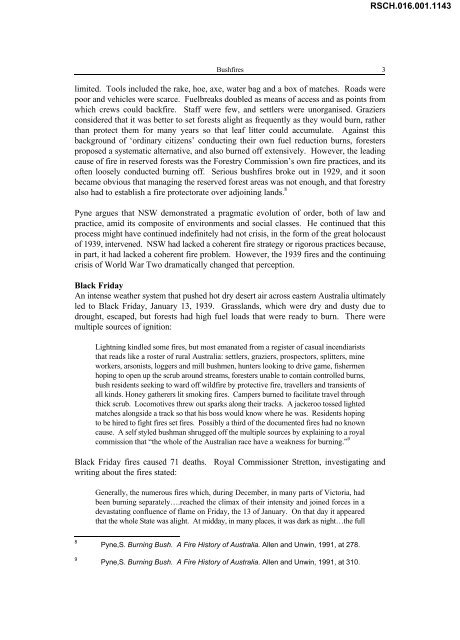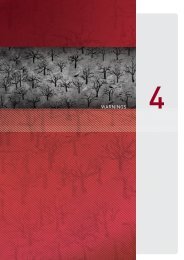RSCH.016.001.1136 - 2009 Victorian Bushfires Royal Commission
RSCH.016.001.1136 - 2009 Victorian Bushfires Royal Commission
RSCH.016.001.1136 - 2009 Victorian Bushfires Royal Commission
Create successful ePaper yourself
Turn your PDF publications into a flip-book with our unique Google optimized e-Paper software.
RSCH.016.001.1143<br />
<strong>Bushfires</strong> 3<br />
limited. Tools included the rake, hoe, axe, water bag and a box of matches. Roads were<br />
poor and vehicles were scarce. Fuelbreaks doubled as means of access and as points from<br />
which crews could backfire. Staff were few, and settlers were unorganised. Graziers<br />
considered that it was better to set forests alight as frequently as they would burn, rather<br />
than protect them for many years so that leaf litter could accumulate. Against this<br />
background of ‘ordinary citizens’ conducting their own fuel reduction burns, foresters<br />
proposed a systematic alternative, and also burned off extensively. However, the leading<br />
cause of fire in reserved forests was the Forestry <strong>Commission</strong>’s own fire practices, and its<br />
often loosely conducted burning off. Serious bushfires broke out in 1929, and it soon<br />
became obvious that managing the reserved forest areas was not enough, and that forestry<br />
also had to establish a fire protectorate over adjoining lands. 8<br />
Pyne argues that NSW demonstrated a pragmatic evolution of order, both of law and<br />
practice, amid its composite of environments and social classes. He continued that this<br />
process might have continued indefinitely had not crisis, in the form of the great holocaust<br />
of 1939, intervened. NSW had lacked a coherent fire strategy or rigorous practices because,<br />
in part, it had lacked a coherent fire problem. However, the 1939 fires and the continuing<br />
crisis of World War Two dramatically changed that perception.<br />
Black Friday<br />
An intense weather system that pushed hot dry desert air across eastern Australia ultimately<br />
led to Black Friday, January 13, 1939. Grasslands, which were dry and dusty due to<br />
drought, escaped, but forests had high fuel loads that were ready to burn. There were<br />
multiple sources of ignition:<br />
Lightning kindled some fires, but most emanated from a register of casual incendiarists<br />
that reads like a roster of rural Australia: settlers, graziers, prospectors, splitters, mine<br />
workers, arsonists, loggers and mill bushmen, hunters looking to drive game, fishermen<br />
hoping to open up the scrub around streams, foresters unable to contain controlled burns,<br />
bush residents seeking to ward off wildfire by protective fire, travellers and transients of<br />
all kinds. Honey gatherers lit smoking fires. Campers burned to facilitate travel through<br />
thick scrub. Locomotives threw out sparks along their tracks. A jackeroo tossed lighted<br />
matches alongside a track so that his boss would know where he was. Residents hoping<br />
to be hired to fight fires set fires. Possibly a third of the documented fires had no known<br />
cause. A self styled bushman shrugged off the multiple sources by explaining to a royal<br />
commission that “the whole of the Australian race have a weakness for burning.” 9<br />
Black Friday fires caused 71 deaths. <strong>Royal</strong> <strong>Commission</strong>er Stretton, investigating and<br />
writing about the fires stated:<br />
Generally, the numerous fires which, during December, in many parts of Victoria, had<br />
been burning separately….reached the climax of their intensity and joined forces in a<br />
devastating confluence of flame on Friday, the 13 of January. On that day it appeared<br />
that the whole State was alight. At midday, in many places, it was dark as night…the full<br />
8<br />
9<br />
Pyne,S. Burning Bush. A Fire History of Australia. Allen and Unwin, 1991, at 278.<br />
Pyne,S. Burning Bush. A Fire History of Australia. Allen and Unwin, 1991, at 310.
















